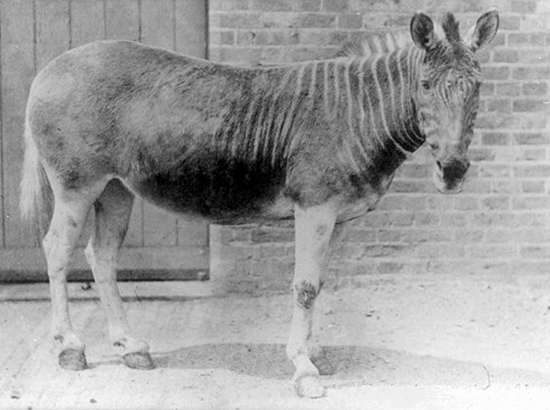For many centuries the hottest continent, Africa, remained a total mystery for the entire world society, as well as its nature and animal habitat could stay safe. The magnificence and attractiveness of local environment continue to be the main issue Africa can boast of, but, in fact, it has preconditioned aggressive and blatant behavior of colonists, engaged in hunting, poaching and animal trade. Quagga is a vivid example of how the entire animal species can become extinct because of overwhelming infringement into environment.
Initially quaggas were recognized as some zebra species that obtained a different skin pattern. Regardless naturalists’ observation of quaggas, antelopes and zebras feeding together on the grasses of African savannahs, these unique animals were later recorded as a separate species. It was done by Johann Georg Gmelin, German geographer, in 1788. The more’s the pity, a century later the last Quagga individual left native lands. It is still referred to as one of the 10 amazing extinct animals.
Quaggas Appearance and Behavior Facts
Notwithstanding animals’ resemblance to common African zebras, they also possessed certain distinguishing features. In particular, they were a bit smaller: males rarely were more than 2 meters long and 1.3 meters high, which is why African indigenous people easily recognized quaggas. They also hunted these animals because of valuable skins and meat, but their impact is far from injuria of the Old World. Many zoologists pointed out that quagga species is a mix of cloven-hooved animals’ features. Firstly, the color and appearance were much alike wildebeests have; secondly, zebras’ pattern were observed on the head and upper body parts; thirdly, horses’ species contributed to quaggas’ small ears and bushy tail. Additionally, visual image and sizes of quaggas were similar to donkeys’ ones. The name of “quagga” has not appeared by chance, as it reflected the sounds animals produced. They were noticed by aborigines and, later, naturalists.

Speaking of quaggas’ essential behavior, it is impossible not to mention some myths. One of them is that these animals, unlike their cloven-hooved “relatives”, were not afraid of attacking hyenas and, in addition, they could even nail predators up. Local farmers are believed to domesticate quaggas, which could scare spotted hyenas. However, these are only hard-to-believe stories. Apparently, quaggas could mix up with wildebeests and ostriches while pasturing in order to have protection from predators: giant birds have an excellent sight, while cloven-hooved animals extremely feel upcoming danger.
Quaggas Extinction Facts
The main reason of quaggas’ extinction is Boer people, who hunted and killed animals for their attractive and firm skins and tender meat. The population of quaggas declined rapidly, especially in the watershed area of Vaal and Orange River. As a result, in 1878 the last individual died in Africa, and in 1883 the last quagga died in the Amsterdam Zoo. At the beginning of the 20th century there were some claims of quaggas’ herd discovery, but they were neglected. In contrast, in 1950s German zoologist Lutz Heck and his South-African colleague Reynold Rau offered to revive quagga species. They took DNA samples from stuffed quagga and concluded it is a subspecies of plains zebra. Breeding project started and in 1988 the first hybrid quagga was born. To date there are 100 individuals of quagga in various conservation institutions.
Guest Post by Maria Kruk, an author for Species.com






Leave a Reply